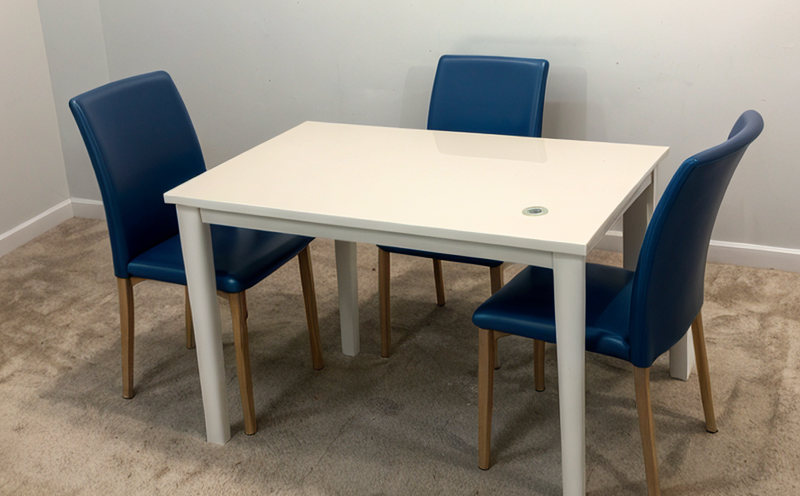ISO 22007 Thermal Conductivity Testing of Furniture Plastics
The ISO 22007 standard provides a comprehensive framework for determining the thermal conductivity of plastics, which is critical in evaluating their performance under various environmental conditions. This testing is particularly important for furniture and interior plastics as they are exposed to fluctuating temperatures within homes and commercial spaces.
Thermal conductivity measures how effectively materials transfer heat from one side to another. For furniture plastics, understanding this property helps manufacturers optimize material choices for durability, comfort, and aesthetics. Factors such as the type of plastic used (polyethylene, polypropylene, PVC), colorants, flame retardants, and other additives can affect thermal performance.
The testing process involves measuring the heat flow through a sample under controlled conditions. The equipment typically includes a calorimeter that maintains a constant temperature differential across the specimen. This setup allows for accurate determination of the thermal conductivity coefficient (k).
Proper preparation of specimens is crucial before testing. Samples should be cut to standard dimensions, conditioned in a specified environment to ensure they are at equilibrium with their surroundings, and free from external influences like humidity or temperature variations.
Accurate results depend on adherence to ISO 22007 guidelines throughout the entire process. Compliance officers can use these tests to ensure product safety and regulatory compliance. R&D engineers benefit from this data when developing new materials that balance thermal properties with other desirable characteristics like flexibility, strength, or appearance.
Quality managers rely on such tests to monitor production processes and maintain consistent quality across batches. By comparing test results against established standards, they can identify any deviations early in the manufacturing cycle, minimizing costly rework.
The importance of thermal conductivity testing extends beyond just understanding material behavior; it influences decisions regarding insulation strategies, fire safety regulations, and overall user comfort in furniture design. For instance, higher thermal conductivity values might suggest quicker heating or cooling times, impacting both energy efficiency and occupant satisfaction.
- Use Case 1: Evaluating the suitability of new plastic blends for cushioning materials in office chairs.
- Use Case 2: Assessing the impact of different colorants on heat retention properties in upholstery fabrics.
- Use Case 3: Determining appropriate insulation layers for outdoor furniture exposed to extreme weather conditions.
- Use Case 4: Comparing thermal performance between recycled and virgin plastics used in interior fittings.
In conclusion, ISO 22007 thermal conductivity testing offers valuable insights into the behavior of furniture plastics under temperature variations. Its application spans multiple aspects of product development, quality assurance, and compliance ensuring that end products meet both functional and regulatory requirements effectively.
Quality and Reliability Assurance
Ensuring the reliability and consistency of test results is paramount in maintaining high standards within industries like furniture manufacturing. Compliance with ISO 22007 ensures that all measurements are conducted under uniform conditions, reducing variability due to environmental factors or operator inconsistencies.
Routine calibration of equipment guarantees precision and accuracy over time. Regular audits by independent third parties help verify the integrity of testing facilities and methodologies. Continuous education for personnel involved in sample preparation, data collection, and analysis further enhances overall confidence in results.
Quality assurance programs supported by rigorous thermal conductivity testing play a crucial role in identifying potential issues early on. This proactive approach allows manufacturers to address defects before they become significant problems affecting customer satisfaction or regulatory non-compliance.
Data integrity is maintained through robust documentation practices, including detailed records of every test conducted. These documents serve as valuable references for future reference and troubleshooting purposes. They also facilitate audits by external bodies ensuring compliance with relevant standards and regulations.
International Acceptance and Recognition
The ISO 22007 standard enjoys widespread acceptance globally, particularly in regions where stringent quality control measures are required. Countries like the United States, Canada, Europe, China, and various other parts of Asia have incorporated its provisions into national standards.
Manufacturers operating internationally find it advantageous to adhere to these guidelines because they align with international best practices recognized across borders. This harmonization simplifies trade procedures and fosters trust among buyers and sellers alike.
Regulatory bodies often specify ISO 22007-compliant testing as a prerequisite for certification or approval of products entering specific markets. Adhering to these standards demonstrates commitment to excellence, potentially opening doors to new opportunities abroad.
Use Cases and Application Examples
- Evaluating Insulation Capabilities: Testing different foam types for their insulative properties in furniture cushions.
- Material Selection: Comparing the thermal performance of various plastic compounds intended for use in outdoor seating.
- Compliance Verification: Ensuring that interior plastics meet local regulations regarding heat retention and transfer rates.
- R&D Innovation: Investigating how modifications to existing polymer formulations affect their thermal conductivity characteristics.
These applications highlight the versatility of ISO 22007 testing in addressing diverse needs within the furniture industry. Whether it's optimizing product designs, ensuring compliance with international standards, or driving innovation through research and development efforts, this standard remains a cornerstone for reliable thermal conductivity assessment.





